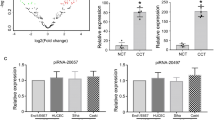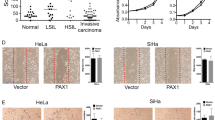Abstract
Objective
PR (PRDI-BF1 and RIZ) domain proteins (PRDM) are a subfamily of the kruppel-like zinc finger gene products and play key roles during cell differentiation and malignant transformation. PRDM5 (PR domain containing 5 PFM2) is a new PR-domain-containing gene. The purpose of the present study was to examine the expression of PRDM5 and evaluate its carcinogenesis in cervical cancer. The relationship between DNA methylation and transcriptional silencing of PRDM5 was investigated in cervical cancer.
Methods
PRDM5 expression was examined in cervical cancer cell lines and cervical tissues (12 normal and 42 cancerous) by using RT polymerase chain reaction (PCR). Methylation status of the PRDM5 promoter was studied using methylation-specific PCR (MSP).
Results
PRDM5 expression is reduced or lost in cervical cancers, compared with normal cervical tissues (P < 0.05). The current study results also showed that loss of PRDM5 is mediated by aberrant cytosine methylation of the PRDM5 promoter. There were 40.5% of carcinomas methylated, while none of normal tissues were methylated. PRDM5 mRNA expression was significantly higher (P = 0.000) in unmethylated (0.2634 ± 0.0674, mean ± SD), compared with methylated tissues (0.1007 ± 0.0993, mean ± SD). Last, treatment with a DNA methyltransferase inhibitor led to reactivation of PRDM5 expression in cell lines that had negligible PRDM5 expression at baseline.
Conclusions
Reduced expression of PRDM5 may play an important role in the pathogenesis and/or development of cervical cancer, and is considered to be caused in part by aberrant DNA methylation.


Similar content being viewed by others
References
Arribas R, Risques RA, Gonzalez-Garcia I, Masramon L, Aiza G, Ribas M, Capellà G, Peinado MA (1999) Tracking recurrent quantitative genomic alterations in colorectal cancer: allelic losses in chromosome 4 correlate with tumor aggressiveness. Lab Invest 79(2):111–122
Chou YH, Chung KC, Jeng LB et al (1998) Frequent allelic loss on chromosomes 4q and 16q associated with human hepatocellular carcinoma in Taiwan. Cancer Lett 123(1):1–6
Deng Q, Huang S (2004) PRDM5 is silenced in human cancers and has growth suppressive activities. Oncogene 23:4903–4910
Du Y, Carling T, Fang W, Piao Z, Sheu JG, Huang S (2001) Hypermethylation in human cancers of the RIZ1 tumor suppressor gene, a member of a histone/protein methyltransferase superfamily. Cancer Res 61(22):8094–8099
Gokul G, Gautami B, Malathi S, Sowjanya AP, Poli UR, Jain M, Ramakrishna G, Khosla S (2007) DNA methylation profile at the DNMT3L promoter: a potential biomarker for cervical cancer. Epigenetics 2(2):80–85
Hasegawa Y, Matsubara A, Teishima J, Seki M, Mita K, Usui T, Oue N, Yasui W (2007) DNA methylation of the RIZ1 gene is associated with nuclear accumulation of p53 in prostate cancer. Cancer Sci 98(1):32–36
He L, Yu JX, Liu L, Buyse IM, Wang MS, Yang QC, Nakagawara A, Brodeur GM, Shi YE, Huang S (1998) RIZ1, but not the alternative RIZ2 product of the same gene, is underexpressed in breast cancer, and forced RIZ1 expression causes G2-M cell cycle arrest and/or apoptosis. Cancer Res 58(19):4238–4244
Huang S (1994) Blimp-1 is the murine homolog of the human transcriptional repressor PRDI-BF1. Cell 78:9
Huang S (2002) Histone methyltransferases, diet nutrients and tumour suppressors. Nat Rev Cancer 2(6):469–476
Huang S, Shao G, Liu L (1998) The PR domain of the Rb-binding zinc finger protein RIZ1 is a protein binding interface and is related to the SET domain functioning in chromatin mediated gene expression. J Biol Chem 273:15933–15939
Jeong DH, Youm MY, Kim YN, Lee KB, Sung MS, Yoon HK, Kim KT (2006) Promoter methylation of p16, DAPK, CDH1, and TIMP-3 genes in cervical cancer: correlation with clinicopathologic characteristics. Int J Gynecol Cancer 16(3):1234–1240
Jiang GL, Huang S (2000) The yin-yang of PR-domain family genes in tumorigenesis. Histol Histopathol 15(1):109–117
Jiang GL, Huang S (2001) Adenovirus expressing RIZ1 in tumor suppressor gene therapy of microsatellite-unstable colorectal cancers. Cancer Res 61(5):1796–1798
Jiang GL, Liu L, Buyse IM, Simon D, Huang S (1999) Decreased RIZ1 expression but not RIZ2 in hepatoma and suppression of hepatoma tumorigenicity by RIZ1. Int J Cancer 83(4):541–547
Jo H, Kang S, Kim JW, Kang GH, Park NH, Song YS, Park SY, Kang SB, Lee HP (2007) Hypermethylation of the COX-2 gene is a potential prognostic marker for cervical cancer. J Obstet Gynaecol Res 33(3):236–241
Kim KC, Huang S (2003) Histone methyltransferases in tumor suppression. Cancer Biol Ther 2(5):491–499
Kim KC, Geng L, Huang S (2003) Inactivation of a histone methyltransferase by mutations in human cancers. Cancer Res 63:7619–7623
Lal G, Padmanabha L, Smith BJ et al (2006) RIZ1 is epigenetically inactivated by promoter hypermethylation in thyroid carcinoma. Cancer 107(12):2752–2759
Lin Y, Wong K, Calame K (1997) Repression of c-myc transcription by Blimp-1, an inducer of terminal B cell differentiation. Science 276(5312):596–599
Oshimo Y, Oue N, Mitani Y, Mitani Y, Nakayama H, Kitadai Y, Yoshida K, Chayama K, Yasui W (2004) Frequent epigenetic inactivation of RIZ1 by promoter hypermethylation in human gastric carcinoma. Int J Cancer 110(2):212–218
Pasqualucci L, Compagno M, Houldsworth J et al (2006) Inactivation of the PRDM1/BLIMP1 gene in diffuse large B cell lymphoma. J Exp Med 203:311–317
Piao Z, Choi Y, Park C et al (1997) Deletion of the M6P/IGF2r gene in primary hepatocellular carcinoma. Cancer Lett 120(1):39–43
Schwendel A, Richard F, Langreck H, Kaufmann O, Lage H, Winzer KJ, Petersen I, Dietel M (1998) Chromosome alterations in breast carcinomas: frequent involvement of DNA losses including chromosomes 4q and 21q. Br J Cancer 78(6):806–811
Shivapurkar N, Virmani AK, Wistuba II, Milchgrub S, Mackay B, Minna JD, Gazdar AF (1999) Deletions of chromosome 4 at multiple sites are frequent in malignant mesothelioma and small cell lung carcinoma. Clin Cancer Res 5(1):17–23
Sonoda G, Palazzo J, du Manoir S, Godwin AK, Feder M, Yakushiji M, Testa JR (1997) Comparative genomic hybridization detects frequent overrepresentation of chromosomal material from 3q26, 8q24, and 20q13 in human ovarian carcinomas. Genes Chromosomes Cancer 20(4):320–328
Takahashi T, Shivapurkar N, Riquelme E, Shigematsu H, Reddy J, Suzuki M, Miyajima K, Zhou X, Bekele BN, Gazdar AF, Wistuba II (2004) Aberrant promoter hypermethylation of multiple genes in gallbladder carcinoma and chronic cholecystitis. Clin Cancer Res 10(18 Pt 1):6126–6133
Tirkkonen M, Johannsson O, Agnarsson BA, Olsson H, Ingvarsson S, Karhu R, Tanner M, Isola J, Barkardottir RB, Borg A, Kallioniemi OP (1997) Distinct somatic genetic changes associated with tumor progression in carriers of BRCA1 and BRCA2 germ-line mutations. Cancer Res 57(7):1222–1227
Turner CA Jr, Mack DH, Davis MM (1994) Blimp-1, a novel zinc finger-containing protein that can drive the maturation of B lymphocytes into immunoglobulin-secreting cells. Cell 77:297–306
Wang XL, Uzawa K, Imai FL, Tanzawa H (1999) Localization of a novel tumor suppressor gene associated with human oral cancer on chromosome 4q25. Oncogene 18(3):823–825
Watanabe Y, Toyota M, Kondo Y et al (2007) PRDM5 Identified as a Target of Epigenetic Silencing in Colorectal and Gastric Cancer. Clin Cancer Res 13(16):4786–4794
Wu Y, Meng L, Wang H, Xu Q, Wang S, Wu S, Xi L, Zhao Y, Zhou J, Xu G, Lu Y, Ma D (2006) Regulation of DNA methylation on the expression of the FHIT gene contributes to cervical carcinoma cell tumorigenesis. Oncol Rep 16(3):625–629
Yu MY, Tong JH, Chan PK, Lee TL, Chan MW, Chan AW, Lo KW, To KF (2003) Hypermethylation of the tumor suppressor gene RASSFIA and frequent concomitant loss of heterozygosity at 3p21 in cervical cancers. Int J Cancer 105(2):204–209
Conflict of interest statement
None.
Author information
Authors and Affiliations
Corresponding author
Rights and permissions
About this article
Cite this article
Cheng, HY., Chen, XW., Cheng, L. et al. DNA methylation and carcinogenesis of PRDM5 in cervical cancer. J Cancer Res Clin Oncol 136, 1821–1825 (2010). https://doi.org/10.1007/s00432-010-0840-9
Received:
Accepted:
Published:
Issue Date:
DOI: https://doi.org/10.1007/s00432-010-0840-9




